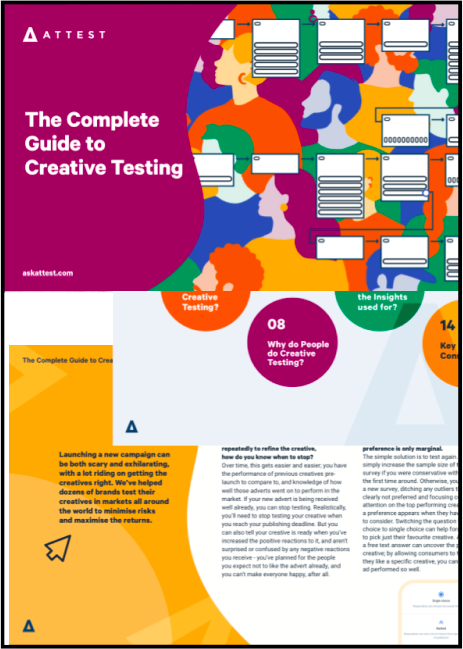9 real-world concept testing examples

Concept testing shouldn’t be done to one general idea. Real concept testing is the art of picking apart your idea, and testing every aspect of it to make sure it will be a success.
It’s important to realise that concept tests go beyond prototypes for your actual product. You can perform concept tests for other aspects as well: the landing page you’ll present it on, the campaigns you had in mind and the price you are considering for it. Because successful products aren’t just successful because of their features, it’s how they’re presented as well.
For an effective concept testing survey, it’s crucial for your consumer insights team to figure out what you want to know about each single aspect of your product, service or event. We’ve gathered some great concept testing examples for market research that will show you some use cases that will get you actionable insights and set you up for successful product launches, over and over again.
Why concept testing is so important
Big brands invest a lot in market research and concept testing, because it’s crucial to maintaining and building great relationships with your customers, since it helps you launch a product that your customers love on first sight. It also prevents financial losses for your business due to product failures.
With concept testing, you can find out what features customers really need for your product, but you’ll also learn what messaging and channels will help you sell your products and services.
Through concept testing, you’ll be able to gather real data that drives decisions. This data helps you get your team on the same page, but is also crucial in conversations with investors and other stakeholders.
Concept testing takes you out of your own head and places your concept ideas in the real world, which allows you to view it through the eyes of your target audience.
Launch products you know your target audience will love!
Test and validate your concepts and campaign ideas with fast, reliable consumer insights. Here are the top research tools to get you started!
See the listExamples of different types of concept testing in practice
Concept testing isn’t a one-time thing, and it involves all kinds of processes. From ad concepts to structure details, there’s a lot you need to get right for a successful product launch, making it an iterative process.
Here are some examples of different concepts where concept testing was done exactly right, or skipped completely – with big consequences.
Purchase intent testing
If you develop a product and people say they want it, that’s great. But it goes beyond wanting it: they have to be willing to buy the product – to put down their hard-earned money for it.
With purchase intent testing, you find out how many people are willing to pay the price you had in mind. You can measure the unpriced purchase intent first to find out how interested people are in the product itself. Later, you can add priced purchase intent, to learn how many people would pay the price you’ve set for the product. You could also add purchase volume to this single concept test: how often would people buy the product?
How Tesla did purchase intent testing for a car that wasn’t designed yet
In 2016, Tesla tested purchase intent in a unique way: they announced the Model 3 (which wasn’t designed yet), and people could put down $1,000 deposits for it. Around 400,000 people did that, which gave Tesla the confidence that their car would sell – and the money they needed to develop it first.

Mallow & Marsh uses Attest to develop and test delicious products
Mallow & Marsh make marshmallow treats with a lot of love and very little compromise. Their creative marketing team has ideas for new products and innovations on a daily basis.
How can a small business like theirs justify spending on new product development? By carefully tracking the ROI of concept testing. To make sure each new product development process is thorough, Mallow & Marsh makes sure to use data to validate their latest tasty product idea, every single time. This helps them justify purchase intent or potential ROI for new ideas, too.
Mallow & Marsh uses Attest as their go-to agile market research tool, testing and validating new products and multiple concepts throughout the development cycle. And as a small company, ROI is crucial.
‘The ROI of using Attest is speed and certainty with our new product offering and go-to-market strategy. Every product concept that’s performed well on Attest has gone on to development, and that’s down to our confidence in the data.’ Alex Caplan, Trade Marketing Manager.

Messaging testing
It’s not only what you say, it’s how you say it. When launching a new product, improving your communication, or switching positioning, your messaging is as important as the product or service itself.
Like Jay Abraham once said, sometimes the best copy to sell a horse is ‘horse for sale’. But sometimes your target audience needs a little more. That’s where messaging testing comes in.
This part of concept testing allows you to set up different messages, looking at your product from different angles, and seeing which one gets your audience to take the desired action. It’s where you make the connection with your brand values and your customers. That could help you build messaging that directly contributes to more sales, or to building stronger relationships – like GymShark did.
Logo testing
A logo is so much more important than you might think, even though there are millions out there already. A brand’s logo is a crucial part of its identity, and you’ll see it all over the place. Best make sure it’s memorable, in all the good ways.
With logo testing, you can let your target audience make the decision for you: what logo do they remember best? Which design draws their attention the most? And how does it transfer to other types of media and formats?
This is where there’s a crossover between concept testing and creative testing. Take a look at our rundown of the top creative testing tools to make sure you’re using a platform that’s ideal for your project.
How Airbnb proved the importance of logo testing by probably skipping it
Testing your logo is a relatively simple part of concept testing, but shouldn’t be overlooked. Because your logo is what people will remember you by. It should be unique. What it shouldn’t be, is ambiguous.
Airbnb failed on both of those things, when they launched their latest logo back in 2014. The creative take on the letter A was supposed to represent coming together and belonging anywhere.
Twitter users saw something else, though: the logo of Automation Anywhere. And genitals. The soft A was apparently inspired by German designer Kurt Wiedeman’s theory that a great logo “is something you can draw in the sand with your toe”.
Both Automation Anywhere and Airbnb became aware of the problem, and Airbnb was the one who got custody over the design after all.
Why did they stick with it, even after it became a laughingstock on the internet? Because in the end, it is a good logo. It’s memorable – maybe even thanks to its ‘funny’ design – and it fits the brand’s values.
For Airbnb, their bet on a logo turned out well for them, but we’d recommend any other brand to thoroughly test out their new logo and visual concept before the big rebranding launch.
Product development testing
There are plenty of reasons to launch a new product, but it should never be because you think it’s a great idea. All products that are successful have been thoroughly tested and have been somewhat ‘approved’ by consumers before they entered the market.
Product development testing is an important part of concept testing for one big reason: to prevent a disaster. What might seem great on paper could be a complete miss in stores and real life. With product development testing, you make sure your successful product concept has all the features your audience is looking for.
Our research experts have created a concept testing template for you that you can tailor to fit your needs!
Create a product that customers buy (and love!)
Attest helps you understand the impact of brand building so that you can maximize your ROI. Create and send surveys in minutes to a 150+ million+ audience.
Get in touch with AttestHow Lego used product development testing find more inclusive product ideas
Who didn’t grow up playing with Lego? Everyone will probably remember playing with them at one point, but in 2011, 90 percent of Lego’s consumers were boys.
There were far more Lego sets based on Star Wars and fire trucks than there were around what was then considered ‘girly’. Boys weren’t specifically their target market, but it had grown to be.
Lego wasn’t giving up on girls, however, and wanted every kid to be able to play with their toys and join their customer base, and feel welcome to do so. So, they went ahead and did some thorough product development testing to get multiple concepts for more inclusive Lego sets.
One of the differences they found in how boys and girls play with Lego, is that boys tend to play with the finished product on the outside, and girls use its insides.
Eventually, Lego launched Lego Friends, which had more of the features girls were looking for, all the way to attention to detail in the interior. Ever since, Lego has been working on developing more inclusive products and target market in a more inclusive way. This led to the launch of their very first LGBTQ+ set in 2021, which started selling during Pride Month.
Advertising and campaign testing
Messaging testing should go hand in hand with advertising and campaign testing. It is different, however. Whereas messaging testing focuses on your overall messaging, advertising and campaign testing can be more focused on a single concept that already contains the message you decided on. You just test out how and where to present it best.
Whether it’s landing pages, social media campaigns, or even billboards, you should always show them to some real consumers through ad testing first before you surprise the rest of the world with them. When a campaign has only been looked at by your team, you have a narrow view and are too close to it. You have to find out what an outsider would make of your creative campaigns.
Pricing and offer testing
Will you be able to build and sell the product you have in mind for a price that potential customers are actually willing to pay? With pricing and offer testing, you find out at what price you will make the most revenue and what extras you could offer to make your product even more desirable.
Pricing and offer testing are crucial for concept testing, because it shows you two things: whether you’ll be able to manufacture the product and still make money, and whether you’ll be making a big enough profit from it to start the adventure. It also determines your marketing campaigns. If it doesn’t work out with pricing, you’ll have to go back to the drawing board.
How Google failed the concept test for pricing the Google Glass
When was the last time you saw someone wearing Google Glasses?
You would think that Google is the king of concept testing, with the team and resources they have. But the outcome from the product concept test for their Google Glass was probably a bit blurry.
You could argue that the wearable Google Glass was launched before the target market was ready, but something that certainly didn’t help was the price: $1,500, for something that was so new and had yet to prove its value to the target audience. Especially if you don’t really need to wear glasses, you don’t want to pay too much, and there was no real competition to compare the price to – so most consumers just skipped it.
Website or rebrand testing
Running concept tests for rebranding might sound expensive – how many designs will you make? – but it’s more than worth it. You can perform concept testing for your new website or branding at a later stage, when you’ve already validated other aspects such as logo and messaging – which should be in line with your website and rebranding.
Why Weight Watchers should’ve done more thorough rebrand testing
Weight Watchers was an established name in the health and diet industry. That’s right: was.
You may have missed it, but they have changed their name. To WW. That stands for Wellness and Wellbeing, or Wellness that Works – nobody is really sure. They weren’t either, apparently, since now their new logo has the words ‘Weight Watchers Reimagined’ next to it.
Weight Watchers changed more than their name. After decades of dieting (since 1963!) , there was a call for a healthier approach to weight loss, and focusing on other health metrics than weight. While WW got that kind of right, their rebranding was bad enough to overshadow their good intentions.
Launch products you know your target audience will love!
Test and validate your concepts and campaign ideas with fast, reliable consumer insights. Here are the top research tools to get you started!
See the listNaming testing
What’s in a name? A lot, actually. Names of brands often seem random. Here are a few examples: Coca-Cola? It wouldn’t mean anything if the drink was never invented. Apple could be everything, yet we rarely think about the actual fruit when someone mentions it. Airbnb has some hints to bed and breakfasts in its name, but Uber is just…a German word?
Naming testing is an important part of concept testing. The naming of a product – or an entire brand – has big implications for your marketing strategy. Your copy and design to start with, but certain names and words also simply spark certain emotions.
Apple is something we’re all familiar with, something we know, perhaps even trust. You can’t immediately say that about words like Microsoft, right? Naming testing is probably also the reason Apple only launches iPhones, whereas Huawei has a Mate, Nova, Enjoy and dozens of other names.
How two big brands proved the importance of naming testing
Ever wondered why the Tinder logo is a flame, and you get matches? It’s a thinker, but the popular dating app’s original name was Matchbox. While that is fun wordplay on finding your right match, it isn’t as clear and could be confused for another product or service (Google was initially named BackRub. Imagine we all adopted that as a verb).
Tinder on the other hand is much more catchy, and can’t be confused for a different app, since it only means ‘dry, flammable material, such as wood or paper, used for lighting a fire’.
Format and structure testing
When you’re concept testing an event, service or event, format and structure testing is crucial. You might have an idea for a festival in mind, but you could only differentiate yourself from others with a unique format that seamlessly fits your audience’s wishes.
If you have service in mind, you probably focus on what you will deliver in the end – but the way your service is structured is just as important for your potential customers. Not to mention for yourself, because it will determine a lot of processes.
With format and structure testing, you take the big picture you have and divide it up into individual blocks. You play around with those to find viable versions and test them out – not only on your target audience, but also internally.
How NASCAR changed the game by introducing a new race format
NASCAR has been around since 1948, and apart from faster cars, not much has changed. Fans watched races, and in the end, saw who won. That was until 2017, when NASCAR decided it was time to shake things up a little, to improve the experience for the race fans.
Instead of just announcing times and winners at the end of a race, they went for a more football-like approach to keep fans more engaged during races, by introducing in-race scoring.
And, also like in a football match, NASCAR introduced breaks. A simple thing that makes a big impact on the viewing experience: TV stations now know when they can air commercials, and fans know when they can go to the bathroom without missing one of the highlights.
Concept testing survey FAQs
Concept testing allows you to validate product and campaign ideas before investing too much time, money and effort in them. By asking customers specific questions about your new product concept, you can be sure your latest ideas will resonate with your target audience. Concept testing survey platforms like Attest help you receive this validation quickly and easily.
Common examples of concept testing include:
– Product development testing
– Brand and product name testing
– Purchase intent testing
– Pricing testing
– Website or rebrand concept testing
– Testing offers, deals, and sale concepts
To learn how Attest can help you test vital concepts (and track how they resonate with potential customers), schedule a demo.
The best way to perform concept testing is to use market research surveys. Using a market research platform like Attest, you can directly ask customers questions about your product, brand and campaign concepts.
Once you’ve collected all your survey data, you can measure vital metrics and validate consumer approval of your ideas. Schedule a demo with Attest’s expert team to see how it works.
Tell us what you think of this article by leaving a comment on LinkedIn.
Or share it on:

